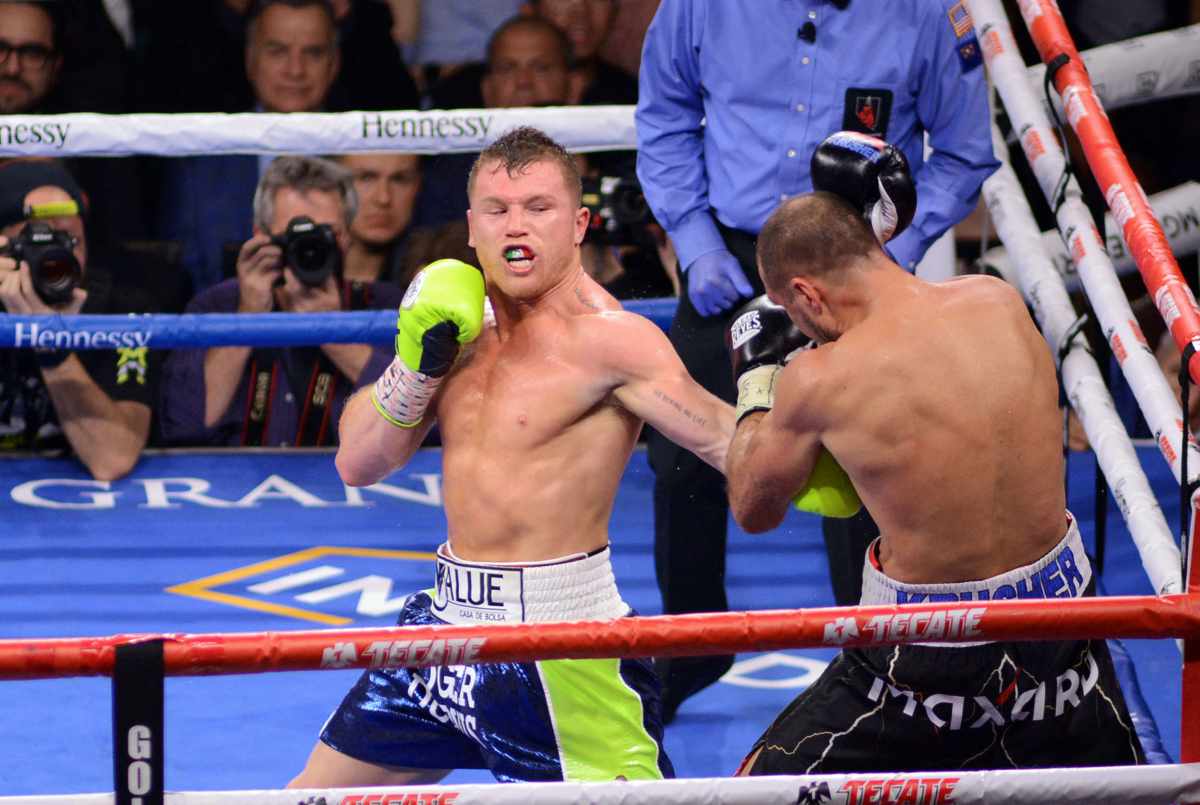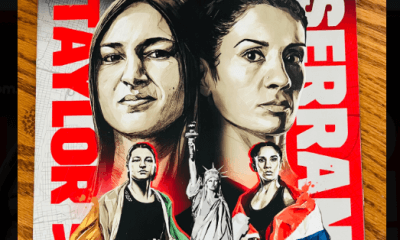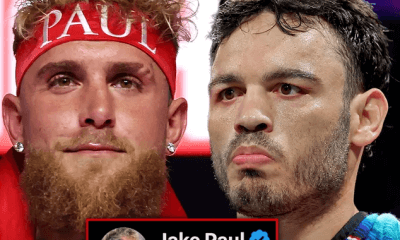Featured Articles
Hits and Misses from Boxing’s Historic Weekend

Fight fans had the first week in November circled for a long time.
After all, Canelo Alvarez was attempting to become one of the very few sitting middleweight champions ever to move up and rip the title away from a light heavyweight king.
But there were tons more fights around the world, too. Mexico’s Miguel Berchelt made the sixth defense of his WBC junior lightweight title. Popular Manchester native Anthony Crolla was competing in front of his home crowd at Manchester Arena in a farewell fight. Heck, there was even a PBC on FS1 card in Maryland.
With all that on the docket, there were lots of swings at making our hits and misses list. Here are the ones that made the cut during boxing’s latest big weekend.
HIT: Canelo Alvarez’s Rare Historical Achievement
Already the reigning middleweight champion and arguably boxing’s biggest star, Alvarez did something pretty spectacular on Saturday night in Las Vegas when he toppled Sergey Kovalev to become the new WBO light heavyweight champion.
No, it wasn’t the narrative that Alvarez became the fourth Mexican to win world titles in four different weight classes, joining Erik Morales, Juan Manuel Marquez and Jorge Arce. In fact, I’m not even sure that Alvarez really accomplished that feat beyond mere technicality. While it’s true Alvarez won legitimate world titles at 154, 160 and 175, when did any of those secondary WBA belts like the one he snatched from Rocky Fielding last year at 168, become part of these historical designations?
What was truly rare and important was that the sitting middleweight champion moved up 15 pounds to dominate such a highly regarded light heavyweight titleholder. Even more impressive was that he did it against such a well-schooled boxer and sharp puncher in Kovalev. Even greater was that he did it by walking the much larger man down to deliver such a brutal knockout in the 11th round.
MISS: DAZN’s Reactive and Disordered Scheduling Decision
DAZN delayed the start of the Alvarez-Kovalev bout until after the finish of the UFC 244 main event between Jorge Masvidal and Nate Diaz and it brought to light a least a couple of reasons to be concerned about the company’s future.
First, it suggested that one of boxing’s biggest stars in Alvarez in one of the biggest fights of the year was less important than a battle between two UFC contenders with double-digit losses on both sides of the ledger.
Second, and perhaps most troubling, it indicated a potentially disordered focus by DAZN executives on prioritizing potential subscribers over the current customer base.
DAZN’s main goal should be delivering top quality content for subscribers. The message instead was that current customers, the ones that pony up every month so DAZN can continue to exist, aren’t nearly as important as potential subscribers who haven’t shelled anything out all year but really might consider it so long as everything is made super convenient for them.
Minimally, that seems based on a scarcity-based mindset, one that suggests there aren’t enough people for there to exist both boxing and MMA fans. Surely that model has been debunked by now.
Moreover, the decision wreaked of desperation. Exactly many more subscribers does DAZN need in order to justify that $365 million contract it gave to Alvarez last year?
Whatever the answer, delaying the start of one of the biggest events for over an hour and a half suggests the brain trust at DAZN might not be making the best decisions right now.
HIT: Miguel Berchelt’s Continued Excellence
Berchelt has quietly put together a sustained run of divisional excellence, and it looks like things might get a whole lot louder soon. Berchelt dominated and stopped former titleholder Jason Sosa in just four rounds on Saturday night in Carson, California. The Mexican displayed his usual knack for throwing huge amounts ofhard punches, and it made for some really solid action.
That’s the thing that makes Berchelt special. Not only has he looked excellent in his six title defenses at 130 pounds, but he’s won those fights with a fan-friendly and aggressive style that makes for good television.
It’s such good television, in fact, that it seems like the 27-year-old from Mexico should be a bigger deal by now. That he’s not already on just about every boxing fan’s must-watch list tells us that his promoters over at Top Rank need to start getting him bigger fights.
Hopefully, that’s about to happen. Undefeated 28-year-old former featherweight titleholder Oscar Valdez seems to be shortlisted for the next crack at Berchelt. That’s a big fight between two guys who really know how to produce quality action, and one that deserves all the bells and whistles of a regular ESPN showcase.
But if that bout falls through for some reason, there are plenty of other 130-pounders to consider, too. The list of backup plans should start with the three other titleholders (Jamel Herring, Andrew Cancio, Tevin Farmer) and go on from there. It’s high time those fights between the top junior lightweights in the world start getting made. If that happens, Berchelt will finally have a chance to prove he belongs among boxing’s biggest stars.
MISS: Evan Holyfield’s Debut Cut Short
Evan Holyfield made his professional debut on the undercard of the Alvarez-Kovalev card, and it seems like people were genuinely interested in seeing how the career of Evander Holyfield’s son would play out.
But we didn’t see very much. The junior middleweight prospect landed a number of punches on opponent Nicholas Winstead right at the opening bell and dumped his unheralded foe to the canvas within the first 10 seconds.
Winstead rose to his feet, looking clear-eyed and ready to continue. But referee Robert Hoyle waved the contest off at 0:16 seconds of the first round anyway, so the fight was over before it ever really started.
Maybe Hoyle saw that Winstead was hopelessly overmatched. That’s certainly possible, and if he stopped the fight because he feared for Winstead’s life, he should be commended for it. Moreover, it’s that was the case, the blame should fall on promoters and matchmakers for making the fight at all.
But it looked more like Hoyle just made a bad call in stopping a fight early that probably should have continued. Sure, it’s always better to stop a fight too early than too late. But what’s best is stopping a fight at the exact right time, and that’s not what happened in Holyfield’s debut.
HIT: The Flair of Blair Cobbs
Is there any more compelling prospect right now than Blair “The Flair” Cobbs?
The flamboyant 29-year-old welterweight prospect has one of the most intriguing backstories in boxing. He employs an awkward but effective style in the ring, and it seems like he might be on his way to becoming one of boxing’s next big things.
To do that, though, he’ll absolutely need to become a better fighter. Cobb stopped journeyman Carlos Cervantes in six rounds on Saturday night, but it sure didn’t look easy. The positive thing to say about it was that Cobb showed resiliency in rising from a first-round knockdown to get the stoppage win.
But the issue the promoters over at Golden Boy Promotions will have on their hands going forward is that Cobb attracts a fanbase that will want to see the fighter steadily move up in competition.
He’s not ready for that quite yet.
If anything, it would be best for the fighter to take the slow and steady approach Deontay WIlder’s team employed in taking that fighter up the ranks. Nobody liked it back then, but it sure has paid off.
Still, Blair is already great at every other part of the sport that’s important. He knows how to attract fans and already seems to wield a gravitational force of personality that most boxers never come close to enjoying.
However this thing works out, many will be watching with great interest.
MISS: The Continued Existence of Farewell Fights
Anthony Crolla defeated Frank Urquiaga by majority decision in what was Crolla’s farewell fight on Saturday in Manchester. It’s certainly understandable why a fighter like Crolla would want one last bout against lesser opposition like Urquiaga. It’s a chance to soak everything in for one last time.
But I’m not sure I’ve watched many farewell fights that didn’t seem like everyone involved was just going through the motions.
Part of what makes boxing special is the passion the fighters muster. Boxing isn’t a game like basketball. It’s physical combat between two souls who have to pour themselves out completely to claim victory.
Farewell fights, such as Crolla’s decision win over Urquiaga, don’t really seem like real boxing. It’s more like a sparring session or something else that people shouldn’t have to purchase tickets to see.
Crolla enjoyed a tremendous career. He won British, Commonwealth and even a secondary world title. He was a legitimate world title challenger and even managed to fight arguably the best fighter of his generation in Vasyl Lomachenko.
But nothing that happened on Saturday in his farewell fight did anything to enhance, or even highlight, those things. In fact, it was a virtually meaningless exhibition that probably shouldn’t have happened at all.
HIT: The PBC’s Unique and Important Ability
With all the other boxing over the weekend, it’s not out of line to suggest most boxing fans didn’t watch the PBC on FS1 card featuring junior middleweight prospect Brian Castano’s stoppage of Wale Omotoso.
Even so, it shouldn’t go unnoticed how many TV slots Al Haymon-managed fighters seem to get these days even if hardly anyone gets to see them.
It might even be frustrating to have so many different fight cards on at the same time. Gone are the days of either HBO or Showtime vying for our attention, or even the minor inconvenience of having to switch back and forth between the two networks when they had competing shows.
Today’s boxing landscape is almost too difficult to follow. There seem to be three or four major cards on every single weekend, many of them going head-to-head against each other. While that can be frustrating (and seemingly even unnecessary), it should be noted that it’s one of the better times in boxing history to be a professional prizefighter.
Of all the competing factions, the PBC seems most adept at putting all sorts of fights across many different networks, many of which often feature fighters that wouldn’t have had a chance for opportunities under the old model.
The best part of that is that it means fighters who otherwise wouldn’t have made as much money 10 years ago are able to secure greater portions for themselves and their families. If that’s not the highest good in boxing, I’m not really sure what is.
Photo credit: Al Applerose
Check out more boxing news on video at The Boxing Channel
To comment on this story in The Fight Forum CLICK HERE
-

 Featured Articles4 weeks ago
Featured Articles4 weeks agoAvila Perspective, Chap. 330: Matchroom in New York plus the Latest on Canelo-Crawford
-

 Featured Articles3 weeks ago
Featured Articles3 weeks agoVito Mielnicki Jr Whitewashes Kamil Gardzielik Before the Home Folks in Newark
-

 Featured Articles22 hours ago
Featured Articles22 hours agoResults and Recaps from New York Where Taylor Edged Serrano Once Again
-

 Featured Articles4 weeks ago
Featured Articles4 weeks agoCatching Up with Clay Moyle Who Talks About His Massive Collection of Boxing Books
-

 Featured Articles5 days ago
Featured Articles5 days agoFrom a Sympathetic Figure to a Pariah: The Travails of Julio Cesar Chavez Jr
-

 Featured Articles3 weeks ago
Featured Articles3 weeks agoMore Medals for Hawaii’s Patricio Family at the USA Boxing Summer Festival
-

 Featured Articles1 week ago
Featured Articles1 week agoCatterall vs Eubank Ends Prematurely; Catterall Wins a Technical Decision
-

 Featured Articles4 weeks ago
Featured Articles4 weeks agoRichardson Hitchins Batters and Stops George Kambosos at Madison Square Garden




















